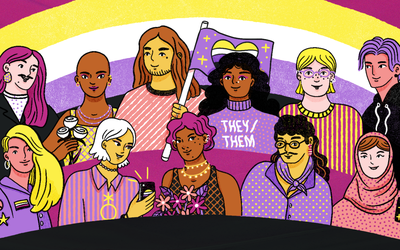Gender nonconformity, explained
May 2, 2021
The concept of gender nonconformity rejects the idea of the gender binary and the social construct of gender.
“You don’t really fit the social construct of being male or female. You fit wherever you want to fit,” said Jay Van Thournout, a senior in industrial technology who identifies as nonbinary.
There is no singular, conclusive definition for gender nonconformity. Gender identity is an extremely personal and individual experience that is different for every person. Generally, gender nonconformity refers to anything that rejects the gender binary of male and female.
“Gender nonconformity is exactly what it says it is; it’s not conforming to the greater societal expectations of gender,” said Andra Castle, assistant director of the Margaret Sloss Center for Women and Gender Equity.
Gender nonconformity can be its own gender identity or it can be an umbrella term for many other gender identities that do not correspond to the gender binary of man and woman. Some gender identities that reject this binary include genderqueer, nonbinary, genderfluid, bigender and agender.
“It is up to individuals to choose what terms they want to use to describe their gender,” Castle said. “You are an expert on yourself. Only you can determine your gender identity.”
People who identify outside of the gender binary can choose any term that resonates with them to describe their gender identity. Gender nonconforming individuals may use a number of different terms to describe their gender or they may change these terms.
“To be gender nonconforming is to object to that rigid categorization,” Castle said. “It’s to blur the lines and move about and expand this closed definition of gender that is common in Western American society,” Castle said.
Jo Allen, a senior in journalism and mass communication, uses she/they pronouns and identifies as nonbinary.
“For me, [gender nonconformity] is just kind of playing around between this mix of masculinity and femininity,” Allen said.
Castle said society often enforces the gender binary and rejects gender identities that do not correspond to the binary.
For example, clothing stores only offer options for men and women, and children’s toys are heavily gendered or designated for either boys or girls. Applications and forms also typically offer “male” and “female” as the only options to describe a person’s gender.
“You might look at a form and there would only be two options in terms of gender, or two options and ‘other,’ which the word ‘other’ is weighted and uncomfortable,” Castle said.
Castle said everyday experiences like shopping for clothing or using the restroom can be difficult for gender nonconforming individuals due to the gender binary that prevails in American society. If you identify as neither a man nor a woman (or you identify as both), “which bathroom do you use?” “Which clothing section do you shop in?” Gender nonconforming people face these questions on a daily basis.
nicci port is the project director for diversity, equity and inclusion and gender and sexual diversity initiatives at Iowa State and uses she/her pronouns.
port said forms of expression like clothing can be clues to a person’s gender identity, but assumptions about a person’s gender cannot be made on their outward presentation.
Castle reiterates this idea by pointing out that individuals don’t know other people’s gender based on how they look.
“We really know nothing about another person’s gender by looking at them,” Castle said. “Everything we know about other people’s gender is what we learn from them vocalizing it.”
Some people who identify as gender nonconforming may have an androgynous appearance, which describes a mix of both masculine and feminine traits. However, a person’s appearance or outward expression does not always indicate their inner gender identity.
Somerle Rhiner, a junior in sociology and women’s and gender studies, said they are sometimes misgendered or their gender is questioned by others when they wear skirts. They said their clothing is a part of how they express their identity, but other people cannot make assumptions about their gender based on what they wear.
“There is this comparison that you have to be androgynous to be nonbinary and that’s how all nonbinary people look,” Rhiner said. “If you don’t look that way or you don’t express yourself in that way, I feel like sometimes you are invalidated.”
Gender expression describes the outward presentation of one’s gender, according to Castle. Castle said clothing and secondary gender characteristics like facial hair can be forms of gender expression, but these characteristics do not inherently have a gender.
Allen said people often make assumptions about a person’s gender based on their hair.
“We see longer hair, we assume female. We see short hair, we assume male. Why is that? It’s just hair,” Allen said.
Castle emphasized that we all make assumptions about others and their gender identities, but these assumptions are not always correct. They suggested people share their pronouns with others and “briefly and sincerely apologize” when misgendering occurs.
Misgendering occurs when a person is referred to in a way that does not reflect their gender identity. This can include using the wrong pronouns (on purpose or by accident), referring to someone as “ma’am” or “sir” in contradiction with their gender identity or simply making an assumption about another person’s gender that is not correct.
“It’s really important to not make assumptions about other people’s gender identities,” Castle said.
People who identify as gender nonconforming can choose pronouns that relate to their gender, but pronouns do not always indicate a person’s gender identity.
“[Pronouns] don’t necessarily tell people about a person’s gender or gender identity,” port said.
For example, a person may use she/her pronouns, but that does not mean she identifies as a cisgender woman.
“We have to stop trying to put people in boxes. We have to stop thinking that if we know somebody’s pronouns, we know everything about their gender and sexuality,” port said.
There are many different examples of gender-neutral pronouns, but they/them are the most commonly used gender-neutral pronouns. Ze/zir or ze/hir are also common gender-neutral pronouns.
port suggested people use they/them pronouns until they know a person’s correct pronouns.
“If somebody misspelled your name or used the wrong pronouns or pronounced your name wrong, that has an impact,” port said. “Misgendering someone is essentially telling someone that you don’t see them, you see them the way you want to see them.”
Allen said they are often misgendered as a male due to their appearance, even though they identify as a woman and use she/they pronouns.
“I can’t go anywhere without being misgendered. Grocery store: misgendered. I go to drop off a package: misgendered. It doesn’t matter what I do,” Allen said.
Allen encouraged others to correct people when they misgender a friend or family member. They said it can be embarrassing to be misgendered, especially when they have to correct people on their own.
“It’s already so hard for us to stand up for ourselves. It’s like, we didn’t even do anything, all we did was walk into the store and we already got misgendered,” Allen said.
Misgendering can also include using an individual’s dead name. A dead name “refers to the name that a transgender or gender-expansive individual used at a different time in their life,” according to PFLAG. Some gender nonconforming individuals choose to change their birth name to a name that better reflects their gender identity.
Van Thournout said they decided to change their name when they began identifying as nonbinary.
“If someone wanted to shorten their name and go by a nickname, it would be like that. It’s the same thing,” Van Thournout said.
Van Thournout said Iowa State does not typically allow students to change their name in their school email, Canvas account and other university accounts.
“A lot of times, the names that people go by are incorrect on Canvas or on Iowa State websites,” Van Thournout said.
Van Thournout said this is an issue for many gender nonconforming people because they are frequently dead named in discussion boards and emails. It can also be emotionally taxing to see their dead name on their accounts every day.
“I really wish people didn’t have to experience that, but we do,” they said. “Iowa State needs to fix their gender nonconforming policies.”
Van Thournout and Allen encouraged people to educate themselves to learn more about gender and LGBTQIA+ issues.
“Education is the biggest part that people are missing out on,” Allen said. “People seem to be very limited on their knowledge when it comes to the LGBTQIA+ community.”
One common misconception is that gender identity and sexual orientation are synonymous. While gender identity and sexual orientation may interact or influence each other, they are distinct identities. Gender identity is one’s inner concept of gender and how they identify as a person, while sexual orientation describes who a person is attracted to.
Allen also encouraged anyone who may be questioning their gender identity to explore their identity and learn more about it.
“As difficult as it is to understand who I am… it has been more freeing than anything to start to live as my authentic self,” Allen said.
port encouraged others to get to know gender nonconforming people as individuals and respect their identity instead of “put people in boxes.”
“Stop worrying about us,” Allen said. “Let us just be us. You exist, we exist. It’s as simple as that, so let’s just coexist.”







